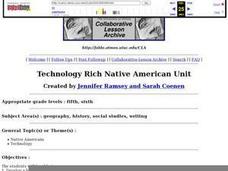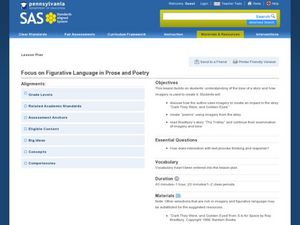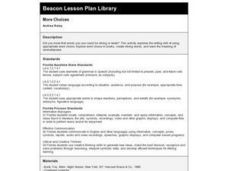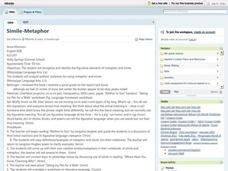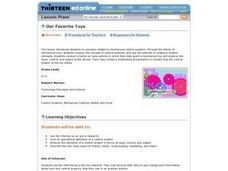Curated OER
Understanding Irony
Students discuss irony. For this language arts lesson, students identify irony and give examples of irony from their lives, a book, and current events. Students classify types of irony.
Curated OER
Poetry on the Web
Eighth graders search a website and locate a poem written by a specific poet whose work appears in the grade 8 anthology. After listening to poetry, 8th graders present oral or written examples of imagery and an analysis of the imagery.
Curated OER
Recognizing Similies: Fast as a Whip
Students review what they have already learned about similies and begin to engage with similies on a deeper and more abstract level as they create their own.
Curated OER
Technology Rich Native American Unit
Student groups retell stories from Iroquois storytellers. They role-play Iroquois women, men and children and explain their roles. They read "Knots on a Counting Rope" and make up their own stories. They create timelines. They visit a...
Curated OER
Reading and Writing Poems About Place
Students explore images, metaphor and simile, personification, detail, inference, tone, meaning. They identify words, phrases, sentences they do and don't understand, and ask questions of themselves and others.
Curated OER
Assembling A Story
Students observe, discuss, and interpret Radcliffe Bailey's work "By the River" by creating a personal narrative of the 18th or 19th century. Internet access is required and related links are offered for teaching aides.
Curated OER
Artistic Symbols
Students compare and contrast symbols used in African and Plains Indian art. In this visual arts lesson, students compare symbols of 2 cultural groups found in their art. Students write a description of what items might have been left...
Curated OER
Comparing Cultures Through Symbols
Students examine symbols used by the Plains Indians. Using examples of African art, they discuss what symbols they use that relate to the Native American symbols. They compare and contrast the two cultures and discuss as a class to end...
Curated OER
Our Illuminated Alphabet
Young scholars write letters of the alphabet and explore how decorated letters can be used to convey stories or symbolic ideas. In this decorating alphabet activity, students create an “illuminated” alphabet in which each letter conveys...
Curated OER
Focus on Figurative Language in Prose and Poetry
Students place emphasis on the use of figurative language when analyzing prose and poetry. In this figurative language lesson, students explore the tone of a story and its imagery. Students read and discuss how the author uses imagery in...
Curated OER
Recognizing Similes: Fast as a Whip
Students review basic knowledge of similes and engage with similes on a more abstract level. For this similes lesson, students define similes and identify examples. Students read and analyze the similes used in poetry by Derricotte,...
Curated OER
Patterns In Poetry: Images (Part 3)
Students explore imagery in poetry. In this poetry instructional activity, students examine how the use of metaphors and similes aid in reading comprehension. Multiple resources are provided.
Curated OER
More Choices
Fourth graders create onomatopoeia for a variety of things such as a mean dog, a crying baby or a doorbell ringing after exploring word choice as used by authors in selected books. They complete a Word Choice worksheet that is attached.
Curated OER
Reading Plays
Students examine the role of tone in a comedy play. They also discover how to paraphrase a passage and explain a character's point of view.
Curated OER
Emotion Similes
Students define what a simile is before writing a poem that is based primarily on similes. They brainstorm and write the poem using the give format. They write drafts, revise and present a final poem.
Curated OER
Stained Glass Window
Students discuss imagery, develop image outlines about events in their lives, find images online that support their ideas, and create stained glass windows that tell stories about those events in their lives using photo or paint program.
Curated OER
Simile And Metaphor
Students engage in a lesson about metaphor and simile while using them in different contexts. They are asked to share some samples that are designed by them to other members of the class. Students practice writing them with the help of...
Curated OER
Personal Peace Symbols
Eleventh graders produce a work of art that symbolizes peace and their experiences with it. In this peace symbolism instructional activity, 11th graders sketch symbols associated with peace view art examples of peace images. Students...
Curated OER
Finding Buck Henry
Students read and demonstrate competence in the general skills and strategies of the writing process via the novel "Finding Buck Henry." They recognize complex elements of plot. Students analyze devices used to develop characters in...
Curated OER
Black Bayou Lake Short Story
Tenth graders use Microsoft Word to create an original short story. The setting must be Black Bayou Lake National Wildlife Refuge. The characters must be animals found at Black Bayou Lake National Wildlife Refuge. The story must contain...
Curated OER
Our Favorite Toys
Students give an operational definition of a control system. They analyze the elements of a control system in terms of input, control, and output and describe the four basic types of motion: linear, reciprocating, oscillating, and rotary.
Curated OER
Unit Plan for The Catcher in the Rye —A “Place-Based” Approach
"People never notice anything." As part of their study of The Catcher in the Rye, class members adopt Holden Caulfield's approach and spend time as quiet observers of their surrounding, recording their observations/reflections in a...
Curated OER
Finding Historical Motifs in Today's Furniture
Students observe and explain continuity with the past in contemporary furniture design.
Curated OER
Depression Era Art
Students choose Depression era art to print out from the Internet. They write paragraphs about how the artists interpreted facts about the Depression in their art. The paragraphs and prints can become a student art critic book.





